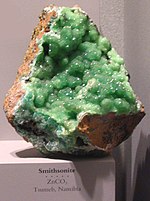Smithsonite
| Smithsonite | |
 A specimen of smithsonite from Tsumeb,Namibia, in the Smithsonian Institution. | |
| General | |
|---|---|
| Category | Carbonate Mineral |
| Chemical formula | ZnCO3 |
| Identification | |
| Color | White, yellow, green, blue, purple |
| Crystal habit | Massive, botryoidal to reniform |
| Crystal system | Trigonal |
| Twinning | None observed |
| Cleavage | Perfect on [1011] |
| Fracture | Uneven, sub-conchoidal |
| Tenacity | Brittle |
| Mohs Scalehardness | 4.5 |
| Luster | Vitreous |
| Streak | White |
| Diaphaneity | Translucent |
| Specific gravity | 4.4 - 4.5 |
| Optical properties | Uniaxial (-) |
| Refractive index | nω = 1.842 - 1.850 nε = 1.619 - 1.623 |
| Birefringence | δ = 0.223 - 0.227 |
| Ultravioletfluorescence | May fluoresce pale green or pale blue under UV |
| References | [1][2][3] |
Smithsonite, or zinc spar, is zinc carbonate ZnCO3, a mineral ore of zinc. Historically, smithsonite was identified with hemimorphite before it was realised that they were two distinct minerals. The two minerals are very similar in appearance and the term calamine has been used for both, leading to some confusion. The distinct mineral Smithsonite was first described in 1832 and named for British chemist and mineralogist, James Smithson (1754-1829), whose estate financed the Smithsonian Institution.[2]
Smithsonite is a variably colored trigonal mineral which only rarely is found in well formed crystals. The typical habit is as earthy botryoidal masses. It has a Mohs hardness of 4.5 and a specific gravity of 4.4 to 4.5.
Smithsonite occurs as a secondary mineral in the weathering or oxidation zone of zinc bearing ore deposits. It sometimes occurs as replacement bodies in carbonate rocks and as such may constitute zinc ore. It commonly occurs in association with hemimorphite, willemite,hydrozincite, cerussite, malachite, azurite, aurichalcite and anglesite. Forms two limited solid solution series, with substitution of manganese leading to rhodochrosite and with iron leading to siderite.[3]




No comments:
Post a Comment